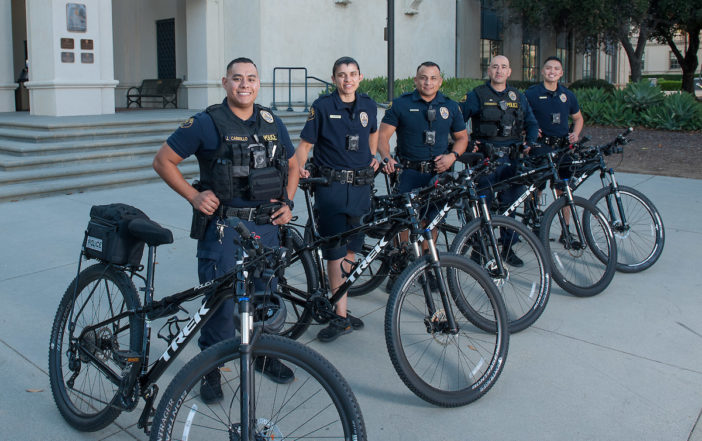For Pasadena Police Officer Jesus Carillo, riding a bike wasn’t something he had done since he was a kid.
Let alone, replace a bike tube, fix a flat tire or dismount a two-wheeler while still in motion.
But these days, the 31-year-old Pasadena Police officer spends four days a week riding his hybrid mountain bike up and down the city’s hillside streets as a member of the new-but-old Neighborhood Action Team (NAT).
The city’s bicycle patrol unit once was an integral part of its Field Operations Division (Patrol and Community Services) before budget cuts cancelled the popular program in 2010. But this September, the NAT team was reinstated and the unit hit the streets once again.
“People just walk up to us. They tell us how happy they are to see us and they end up talking to us about the neighborhood,” Carillo said. “It’s a great way to interact with the community. People feel comfortable when they see us out there on our bikes.”
The NAT team falls into Pasadena Police Department’s community services umbrella, which takes specialized patrol units to help improve the quality of life in neighborhoods. This can mean assisting the homeless, working with panhandlers, getting rid of bulky items, enforcing litter ordinances, and having an overall presence in the community.
“Word travels fast in neighborhoods,” said Sgt. Richard Padilla, who leads the NAT team. “People learn we are here … we help keep street clean, keep communities safe and work on the quality of life of a neighborhood. That’s what was missing for several years – we were here, but couldn’t take care of the little things.”

Members of the re-formed Pasadena PD Bike Team. From left, Officers Alfonso Garcia, Raphael Santiago, Pete Covarrubias, Inga Woiwode and Jesus Carrillo.
The re-formed NAT team is made up of Jesus Carrillo, Inga Woiwode, Alfonso Garcia, Pete Covarrubias and Raphael Santiago. Each police officer was selected for their high motivation, leadership skills, ties to the community, philanthropic attitude and a good sense of calm and control.
Although, knowing how to ride a bike wasn’t a requirement to join NAT, learning how to fall was.
“The first thing we all had to learn was how to fall. I didn’t even know there were different ways …,” said Covarrubias, who had little-to-no experience bike riding before becoming a member of NAT. “When I came on, I didn’t even know how to use all the different gears. But once I took the training class and practiced with the team – I’m a decent rider now.”
Everyone on the team was required to take a three-day tactical mountain bike training course, where they spent hours learning everything from bike maintenance to proper police skills from a two-wheel vehicle.
“We teach our students how to ride up to people in a safe, quiet and stealth approach. How to dismount a bike safely,” said Sgt. Padilla. “We do night training, so officers can see what it is like to ride at night and we also train officers how to shoot from a bicycle. It’s different than being in a patrol car.”
The police officers go through a series of steps and obstacles that can assist them with learning how to patrol on two-wheels. This includes testing one’s endurance up one of Pasadena’s steepest hills along Lida Street. Everyone must be able to ride to the top of this massive hill before they can take their final exam.
For those who have already passed the bike exams you can find them zig-zagging through the picturesque streets of Pasadena and meeting the community.
“You see so much more on the ground and people see you, too,” said Officer Raphael Santiago. “You are out in the open and visible. People talk to us and we seem much more approachable … it’s a great way to see both ends of the (community) spectrum.”
 Behind the Badge
Behind the Badge



